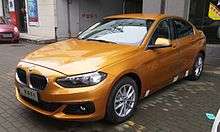BMW 1 Series
The BMW 1 Series is a range of subcompact executive cars (C-segment) manufactured by BMW since 2004. It is the successor to the BMW 3 Series Compact and is currently in its third generation.
| BMW 1 Series | |
|---|---|
 | |
| Overview | |
| Manufacturer | BMW |
| Production | 2004–present |
| Body and chassis | |
| Class | Subcompact executive car (C) |
| Layout | FR layout (2004–2019) Front-engine, front-wheel drive (2019–present) Front-engine, all-wheel drive (2011–present) |
| Chronology | |
| Predecessor | BMW 3 Series Compact |
| Successor | BMW 2 Series (for coupé/convertible) |
The first generation was produced in hatchback, coupe and convertible body styles. Since the second generation (introduced in 2013), the coupé and convertible models have been marketed as the 2 Series, therefore the 1 Series range no longer includes these body styles. A sedan model became available for the Chinese market in 2017.
The 1 Series is BMW's entry level of model range. Unusually for a small car, the 1 Series range is mostly rear-wheel drive, (except for the F52 sedan, which is front-wheel drive) with optional all-wheel drive being available on some models.
An M version was produced for the first generation: the BMW 1 Series M Coupe, which was succeeded by the BMW M2.
First generation (E81/E82/E87/E88; 2004–2011)
_5-door_hatchback_(2011-01-13)_01.jpg)
_rear-3_20100914.jpg)
The BMW E81/E82/E87/E88 is the first generation of the 1 Series, which was produced from 2004 to 2013. It replaced the 3 Series Compact as the smallest and most affordable vehicle in the BMW range.
The body styles consist of a 3-door hatchback (E81), 5-door hatchback (E87), 2-door coupe (E82) and 2-door convertible (E88).
The engines available were four-cylinder diesel and four- and six-cylinder petrol, in both naturally aspirated and turbocharged forms. Unlike most hatchback competitors, the E81/E82/E87/E88 uses rear-wheel drive (instead of front-wheel drive).[1][2]
The 1 Series accounted for nearly one-fifth of the total BMW sales in 2008.[3]
Second generation (F20/F21; 2011–2019)
_5-door_hatchback_(2015-07-03)_01.jpg)
_(cropped).jpg)
The F20/F21 is the second generation of the 1 Series, which was released in 2011.
The body styles of the F20/F21 range are a 3-door hatchback (model code F21) and a 5-door hatchback (model code F20).
For the second generation of 1 Series, the coupe and convertible models were spun off to create the BMW 2 Series range.
The F20/F21 was initially powered by four-cylinder petrol, four-cylinder diesel and six-cylinder petrol engines. In 2015, three-cylinder petrol and diesel engines were added to the model range. All engines are turbocharged.
Unlike most hatchback competitors, the F20/F21 uses a longitudinally-mounted engine and rear-wheel drive (instead of front-wheel drive) for most models. The F20/F21 is the first 1 Series to offer an optional all-wheel drive (called "xDrive" by BMW).[4]
Facelift (2015)
The 1 series went through a significant face lift in 2015 which mainly consisted of a re-design of the shape of the front and rear light clusters along with changes to the front and rear bumpers to accommodate the new clusters accordingly. They also released a M140i which had a 6-cylinder, 3.0-litre engine producing 340 hp.
1 Series sedan (F52; 2017–present)


The 1 Series (F52) is a four-door sedan that began production in 2017 in China. It is made by BMW Brilliance, a joint venture between BMW and Brilliance Auto. The F52 uses the front-wheel-drive UKL platform shared with the X1 (F48) and Mini Hatch.[5][6] The car is also sold by BMW in Mexico starting in 2018.
Third generation (F40; 2019–present)

The 1 Series was redesigned for 2019 models, featuring the UKL2 front-wheel-drive platform which is shared with the F48 X1 and the F60 Countryman. It will be offered with 5 engines; the base model is the 116d, while the range-topping model is the M135i xDrive. Transmissions include a six-speed manual, a seven-speed dual clutch automatic and an eight-speed automatic.[7]
References
- "BMW 1 Series SE review". www.carbuyer.co.uk. Retrieved 24 October 2017.
- "1 Series - E87 (2004 - ...)". www.bmwheaven.com. Retrieved 24 October 2017.
- "Annual Report 2008" (PDF). BMW Group. March 2009. p. 21. Archived from the original (PDF) on 6 January 2010. Retrieved 1 July 2015.
- "BMW Group PressClub Global". press.bmwgroup.com. Retrieved 2011-10-15.
- Horatiu Boeriu (21 November 2016). "BMW 1 Series Sedan makes world debut at Auto Guangzhou 2016". BMWBLOG. Retrieved 31 January 2017.
- Stefan Ogbac (18 July 2016). "2017 BMW 1 Series Sedan Revealed for Chinese Market". Motor Trend. Retrieved 31 January 2017.
- Golson, Daniel (28 May 2019). "The New BMW 1-Series Is a FWD-Based Hot Hatchback with 302 HP". Car and Driver. Retrieved 28 May 2019.
| Wikimedia Commons has media related to BMW 1 Series. |